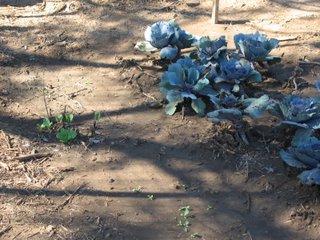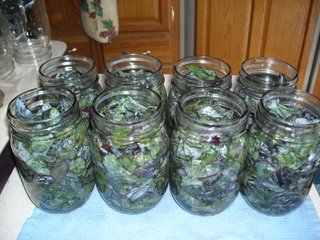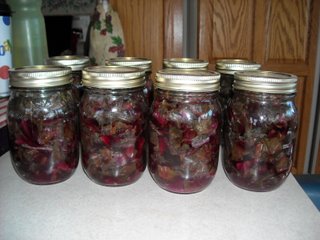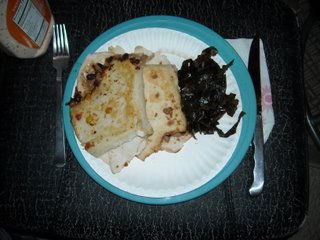We had a drought last Summer and Fall which really affected the quantity and size of many of our garden vegetables. The time came to harvest our red cabbage from our 2008 Fall garden, and the heads were small and did not really look like cabbage heads but more like a bunch of leaves loosely wrapped around or falling away from each other. Dave said we had to at least try to do something with them. Our neighbor, Michael, mentioned you could make sauerkraut with cabbage, so we thought that might be the best way to go.
I looked up the simplest recipe I could find and hoped for the best.
Here is the cabbage in our garden waiting patiently to be harvested by its novice owner (pick me, pick me!!)
I washed all the cabbage leaves and cut them up with a knife because they were too loose to shred with a shredder or grater. I put the leaves in two 9×13″ pans, added the proportionate amount of pickling salt, and mixed well with my hands. There wasn’t much moisture to be drawn out of the leaves, so I had to add a lot more water when putting them into canning jars. After about 24 hours +/-, I prepared pint canning jars and filled them up with the cut-up cabbage leaves adding water, leaving 1″ head space, and screwed on the lids. I followed the instructions to put the jars into a pan (or lined box in my case) because as they started to ferment, there was some (not much) overflow leakage.
Then I stored the jars at room temperature for six weeks and turned them upside down several times over the course of those weeks to distribute the brine and keep everything moist.
At the end of the six weeks, I opened up all of the jars and emptied them into a large sauce pan, simmering them for about five minutes. Yep, it smelled and tasted like sauerkraut, although it was very dark green and more coarse than the kind you buy at the store. Although turning the cabbage into sauerkraut is a preservation method in itself, I proceeded to can the pints of sauerkraut and put them down in our root cellar in order to preserve them for as long as possible. Since we are not generally sauerkraut eating folks, I needed all the time I could get to figure out more ways to fix it!
Wow! I couldn’t believe that we were able to make sauerkraut and preserve it from what appeared to be pretty lifeless leaves. What a wonderful blessing! I’m very thankful to be learning these valuable lessons in food preservation and to be able to witness God’s direct provision from planting to our table.
Susan




It looks good! But, you didn’t say how it tasted… 😉 So, how was it? I LOVE sauerkraut!
😀
Hi Ginny!
Thanks for your comment. Well, admittedly, Neither Dave nor I have been big sauerkraut eaters so I can’t even remember what store-bought kraut tastes like. But it did taste pretty much like what I remember sauerkraut to taste like and was actually very flavorful! We’re just not used to it and it is a rather strong taste. I just need to find more ways to put it into recipes or on top of stuff for variety. I’m kind of curious to see what it tastes like on a good old chili dog or something like that. If you have any recipes or ideas I’m all ears (or eyes in this case 🙂 Thanks again!
Sue
Oh, Susan! My favorite way to eat sauerkraut is in the pressure cooker. I put a couple of pork chops on the bottom of the cooker (on top of the rack), chunk up a couple of potatoes and put those on top of the chops, then pour and spread a pint of sauerkraut on top of all that. Add about 1/2 cup of water and bring to pressure and cook for 15 minutes. Let the pressure come down by itself and enjoy! I’m sure it would be good with beef, too, but I think you all have some pork. 😉
A pressure cooker is different than a canner and I would recommend that you get a stainless steel one, if you can. A good size to get is six quarts. Small enough, yet big enough. 😀
Enjoy!
Hi Sue,
I make quite a bit of kraut and have some thoughts. I watched David just this morning tip up an open jar and drink a couple gulps of the juice. Homemade kraut is a milder, more complex taste than the store bought canned stuff, which to us tastes like metallic vinegar. I’ve never tried the jar method, but have been told it does work well. Kraut can be added to goulash type dishes during the cooking and it becomes quite a bit milder. I have a recipe for an awesome Czech goulash that I’ll try to find for you. I’m wondering of the red cabbage, beings as it turns so dark green, might make a stronger kraut? I’ve read about making kraut with collards and actually tried it lsst year but it was really bitter and strong. I may try it again with some variations, though. You can add things like onion, hot peppers and garlic to kraut and make it into something more like Korean kimchi. Caraway seed is the traditional eastern European addition. In some parts of Czechoslovakia they prepare the finished kraut for serving by adding sugar for a sweet pickle kind of taste.
Judy
Wow, Ginny and Judy, thanks so much. You both have given me some excellent information. Judy, I would love that goulash recipe and I think you’re probably right about the red cabbage kraut being a bit stronger. Ginny, I don’t have a pressure cooker but I hope to try that pork chop recipe in our solar oven to see if it works there. Much appreciated!!
Hi Susan,
Thanks for sharing your Kraut experience with us. I grew just 6-8 cabbage plants last year from seed (the same kind) and they blessed me with different maturing times, so I didn’t make kraut as I thought I might upon planting them. Our family grills good old Brats fairly often, and of course use kraut on them with onion, ketchup and mustard. I often buy the refrigerated bagged kraut which I like the taste of better than canned. We use the leftover kraut in various hotdishes or with other meats like baby back ribs, chops, even chicken hot dishes or on the side. I’ll have to look up the jar method you share here, as I’ve only seen “crock methods” before.
Judy-
“I watched David just this morning tip up an open jar and drink a couple gulps of the juice.”
That’s hilarious. Sounds like something Jeff would do. He just drank directly out of some jug in the frig…. (can’t recall what right now), probably just a 2 litre coke or something, about 2 wks ago; and I said “Hmmm….I guess you consider the rest of that yours huh?”….ribbing him a bit. He just smirked and said “I guess so.” I said “I just feel priveleged to have witnessed your claim.” (roll of eyes)
My mom used to make Kraut before I was old enough to recall….but she often pointed out the wooden sliding/steel bladed kraut cutters at sales, antique stores, etc. and claimed they worked well. Anyone have one of those?
Anyway, happy krauting, David and Susan!
Beth
Susan,
Here’s that recipe:
Segedin Goulash
1 1/2 pounds fresh pork, cubed
1 medium onion, chopped
3 tablespoons lard
1 teaspoon paprika (homemade is the absolute best)
1/2 teaspoon caraway seed
salt to taste
1 cup water
1/2 pound sauerkraut (again, homemade is the way to go)
3 tablespoons flour
1 cup sour cream (Daisy brand or homemade is my preference. Yogurt will work also)
Fry onion in 1 tablespoon lard. Add pork, paprika, caraway and brown well. Add salt and 1/2 cup water, cover, and simmer for 45 minutes. Add 2/3rds of the sauerkraut and simmer 30 minutes longer. Brown flour in remaining lard, stirring well, and add to meat with remaining 1/2 cup water; simmer for 5 minutes. Add sour cream and the remaining sauerkraut. Bring to a boil and serve. Serves 4 to 6.
Beth, I’ve coveted those kraut cutters but especially now with such limited space I’ll probably stick with my knife. I have found that my kraut turns out fine even cut courser than the 1/8″ shred most recipes call for. I put the cores in also, because David has fond memories of fishing them out of his great granny’s kraut as a special treat.
Judy
Judy,
That recipe sounds DEE-LISH! Thanks so much for the follow-up. And, Beth, your tips sound wonderful as well. I REALLY appreciate all of these comments and input as I’m such a novice at this and need all the help I can get. I owe ya!
Sue
When in drought make kraut!
I don’t have any recipes for it but I do love to eat it. Thanks for the idea. I might try to make some of my own this year.
Hello again,
Was just researching “kraut cutters” initially and then the “jar method” for fermenting kraut. Here’s one interesting website I just read through, where she even shares curing a health problem with kraut, and shares a gallon jar krauting method. Interesting, and allows kraut to be made in smaller batches quickly.
http://www.thefamilyhomestead
.com/homemadekraut.htm
Perhaps you’ve seen before…but if not, enjoy.
Beth
This is soooo cool. I can’t wait to make some myself.
Michael